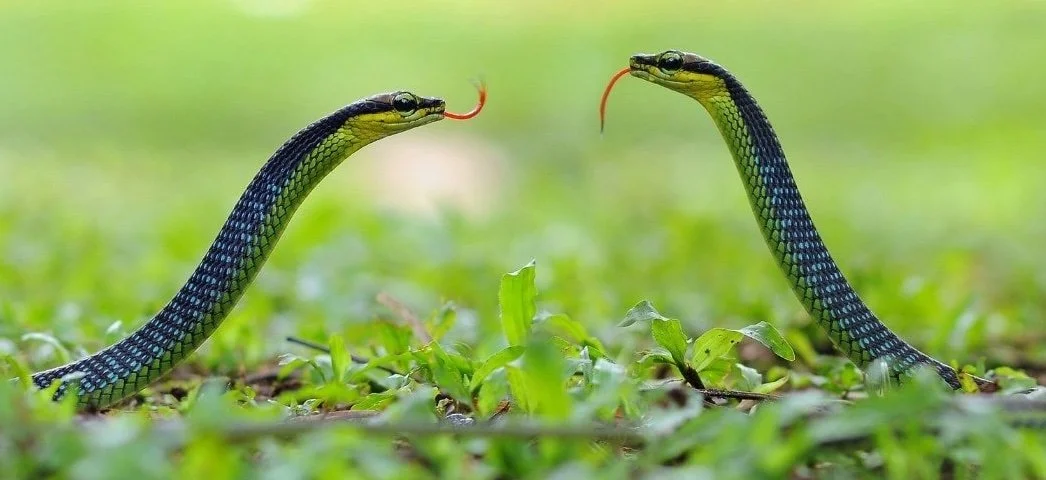Year of the Yin Wood Snake
Written by Paul Arellano
Welcome to the New Year of the Yin Wood Snake! On January 29th, 2025, we enter the lunar year of the Snake: a time of inner transformation, as well as great socio-political changes, as we collectively and individually begin the process of “shedding our skin” to adapt in a changing world.
Arriving on the tail end of the Wood Dragon year, where we saw many dramatic changes take place worldwide that will continue to have ripple effects for years to come, the year of the Snake is the time to adapt internally to the external world as it changes around us. We are faced with global challenges beyond our control that will dictate much of the narrative this year. Rather than trying to stop or avoid these changes, the year of the Wood Snake invites us to consider how we can grow as individuals and continue to nurture what we wish to see in the world, even in the face of uncontrollable global forces. This is a time when we can begin to align our inner self - attitudes, beliefs and habits - to make sense of and come into productive relationships with all of the external changes going on around us. Inner transformation helping in response to external conditions and challenges is what the Wood Snake year is all about.
There is a parable about Gandhi that is the perfect summary of Wood Snake energy. As the story goes: A mother once brought her child to Gandhi and said: “All day long my child eats sweets. It’s not good for him, and I tell him to stop but he won’t. He doesn’t listen to me, but maybe he will listen to you. Will you please tell him to stop eating so much candy?”
Gandhi replied, “Come back in one week.”
Obediently, the woman left and brought her child back a week later, at which point Gandhi said, “Don’t eat so many sweets, they are not good for your health!” The boy nodded and seemed to understand.
But the mother did not understand. “Why did we have to wait a week for you to say that? Couldn’t you have just told him that last week?” The woman asked.
“I could have,” Gandhi replied, “but last week I still ate sweets myself. So I spent the last week not eating any candy, so I could tell him this today, and he would believe me.”
The woman, understanding at last, thanked Gandhi and left with her child.
The power of what Gandhi conveyed to the boy was not about the intensity of his words, nor did he use force to try and compel another to do something against their will. Instead, it was his own internal transformation that gave him the authority and authenticity to deliver a meaningful message that could create lasting change. This is the lesson for us to study during the new lunar year of the Wood Snake.
Snake as Symbol
The Snake represents transformation, much like the Dragon before it, but with the important distinction that the Snake’s transformative power is entirely internal. While the Dragon is a combination of all other 11 animals of the zodiac (and as such represents a metaphysical, cosmic power that brings about new creation and change), the Snake by contrast has no fixed nature. The snake is an animal capable of shedding its own skin and is thus symbolically considered to be able to transform and shapeshift as needed. (to learn more about the individual animals of the Zodiac, check out our monthly blogs here!)
The duality between Snake and Dragon, and the evolutionary process these years symbolize, can be further understood by exploring their Yin-Yang relationship. While the Dragon is a Yang animal - symbolizing activity, movement, energy and the external - the Snake is a Yin animal. The Dragon is all external - its power and potential are visible in its blended features, it can fly, dive to the bottom of the ocean, change the seasons and turn the stars in the sky, etc. The Snake by contrast seems very humble: it lives out of sight, keeps to the shadows and is rarely seen. It has no limbs, no special features and yet exists across the planet from deserts to rainforests to prairies to swamps and wetlands and everything in between, as long as there is enough sunlight and warmth. This displays the Snake’s remarkable adaptability, despite its simplicity. The fact that Snakes are cold-blooded and need the warmth of the sun is important because, unlike the Dragon, Snakes are not agents of change themselves. Rather, Snakes need an external Yang force like the sun to draw on, so they are passive and responsive rather than active and creative. Nevertheless, with enough external Yang energy, Snakes can transform to live in virtually any setting, from burning deserts to the tops of trees, underwater and underground. This remarkable versatility and capacity to consciously adapt in relationship to outer conditions is what defines the Snake symbolically.
In acupuncture theory, all the animals in the Zodiac are associated with an organ of the body. The Snake represents the digestive organ of the Spleen, whose function mirrors and elaborates the symbolic meaning of Snake. While the stomach is responsible for taking in and breaking down food, the Spleen in turn transforms this digested food into us, liberating the energy of the external world from the food we eat and creating our physical body, blood and vital energy. In this way, the Spleen follows the same principle as the Snake: taking in energy from the world around us, adapting and allowing that energy to fuel our growth and transformation. The saying “you are what you eat” is a nod to both the Spleen and the Snake (whose last meal can often be seen bulging in its belly). In other words, how we grow and adapt depends on what resources we have at hand, what food there is to eat, what opportunities there are for us as individuals, and what collective forces are at play. These determine much of our position and direction in life, with our values and goals playing out through what means we have access to. The Snake year is an invitation to pay close attention to how our outer world becomes part of us, but within that transformation, how we can retain our personal values and beliefs - transmuting the external conditions into ourselves, rather than letting ourself become subject to and controlled by external forces.
To fully grasp the meaning of this year, we have to combine all this symbolic information about the Snake (as well as anything you personally know about snakes - there’s far too much to write here, but it is all relevant) with the symbol of Yin Wood to understand deeper layers of significance for the year.
Understanding the Yin Wood Snake
There are five elements in Chinese cosmology that are split into two aspects each, Yin and Yang. As with the Dragon and the Snake discussed above, these Yin/Yang pairs symbolize the internal and external processes of each element, respectively. For Wood, whose overall gesture is of growth and expansion, Yang Wood is the active, visible growth of Spring: new buds, leaves, shoots, flowers and branches, the sapling bursting from the ground and the opening flower. Yin Wood, on the other hand, represents the invisible growth of Winter. Even when the flowers are gone along with the leaves and the bare branches clatter together in the cold wind, trees continue to grow underground. Winter is the time when root systems expand and grow to establish themselves in preparation for the next cycle of spring growth. Therefore, Yin Wood represents both internal growth and established or old growth: the parts of a plant that are firm and steadfast, ready for the next round of buds and shoots to emerge. In our own life, this represents resources already established, and the process of maturation: an internal development of character.
Yin wood energy is the foundation from which we can grow and expand, but also contains the principle of retreat. Just like the energy of a tree retreats to the roots in winter time to preserve itself for the coming spring, the energy of Yin Wood instructs us to consider when it is best to step back and wait, saving our energy for when it can be truly useful rather than moving forward when our energies will be wasted and exhausted in the process. All of these concepts blend together with the symbol of the Snake as an internal, transformative agent adapting to external changes, and together give us the overall symbol of the Yin Wood Snake.
Looking at these symbols together, the year of the Wood Snake emphasizes an internal state of growth and maturity, even before any external signs of change show themselves. This internal growth provides the “rooting” in ourselves to transform and adapt to new conditions while retaining our principles and values. Keeping with the example of roots growing during the winter, this is a time to establish ourselves firmly in our beliefs, practices and relationships so that, when the time comes to act outwardly again, we have a solid basis to move from, and won’t be caught off-balance or without resources. Even though this year might lack the glamour and flashiness of the Dragon before it and the Horse year to come in 2026, the Snake is a crucial break in the momentum, allowing us to shore up our own health, well-being and community connections in order to be prepared for what comes next.
Shedding Our Skin: The Wood Snake Year for Individual Growth
For most of us, this is not a year when our personal agency will create large-scale changes in the world. That is not to encourage apathy or say we shouldn’t care (although both are risks in the Wood Snake Year we should be mindful of). Rather, we should keep a realistic view of what we are up against and focus on developing a different kind of strength than external power. Like the story about Gandhi, there is an internal process of growth and maturation we have to undergo to confront the challenges that face us individually and collectively. The story about Gandhi also contains an unspoken warning: if we have not gone through the internal process of transformation, even our best intentions might not create the outcome we would like to see. So even if it is not glamorous and no one else can tell, this inner growth matters greatly. The Yin Wood Snake Year is much like the week Gandhi took off from sweets. There was no grand message delivered, no guarantee that what he was doing would have any effect on the outer world, but nevertheless it becomes the central moment the entire story pivots around.
On an individual level, the Yin Wood Snake encourages us to investigate what changes we would like to see in the world, and furthermore to honestly ask ourselves how our own behavior and relationships reflect this desire for change in the world. There is work for all of us to do here, and if we want to see the world shift at large, it is vital that we each take an active role in developing our own capacities for compassion, generosity, patience, kindness and forgiveness, all without ignoring the uncompromising world around us that we must navigate. Somewhere in between perfectionism and apathy is a sweet spot where we can be unflinchingly present and allow ourselves to freely adapt to the conditions of the world around us. Yet even in this stillness there is always the possibility – like a Snake laying in wait, poised for the right opportunity – that if we stay alert and connected, we will find the perfect moment to deliver a meaningful, impactful message that can create real change, made possible only by our own inner growth, maturity and patience.
By developing strong roots in our convictions and values, we can respond quickly and decisively to any unexpected situation, knowing what our priorities are and acting accordingly. Without the time to reflect and develop an intimate understanding of these priorities and values, however, we will be caught off guard when unexpected changes take place around us, unsure of how to proceed at best, or acting out our own worst impulses and fears at worst. The year of the Wood Snake is the time to develop the muscle of inner knowing and alignment, so we have the capacity to act when we need to with clarity and conviction.
The Snake at Large: Global Outlook on the Year of the Wood Snake
Worldwide, we have experienced incredible collective upheaval since 2020, which was the Year of the Rat and beginning of a new 12-year Zodiac cycle. At this point in the cycle, the Snake represents a reckoning with these external changes, which are often difficult to understand and accept, and begins the process of “internal” changes in social, political and ideological formation that follow from the transformations of the outer world. There will still be global narratives and conflict playing out, but the Wood Snake much more emphasizes events happening within our region and countries, rather than external conflicts or events.
Just like the individual notion of transforming our relationships and habits to adapt to the changing world, the Year of the Wood Snake is a time when social movements emerge or gain momentum seeking to make sense of and adapt to (or else control) the global changes of the past few years. Historically, Wood Snake years have been times when large-scale social and political movements build up and reach critical tipping points, and the whole structure of society can shift. The changes the Wood Snake brings to society and politics are uncomfortable, and often involve incredible hardship and uncertainty for civilians caught in between global forces and national/regional responses to managing these changes.
Yet there are valuable lessons to be learned from past Wood Snake Years. The most recent of which was 1965, when Martin Luther King Jr. and other Civil Rights leaders led marches in Selma, Alabama that were met with State-supported violence and suppression. What is important to highlight is that the non-violent protestors had spent months and sometimes years practicing and developing the internal strength to refrain from responding to violence with more violence. It was the dedication of brave individuals who had internally cultivated the capacity to suffer hatred and abuse without responding in kind that ultimately highlighted the abuses and injustice that took place on the way from Selma to Montgomery and sparked widespread public outrage at the status quo. So: how we respond to the crises and injustices around us matters, and it is through developing a deep connection and commitment to our own morals that we create the possibility of developing a new narrative, rather than responding to violence with violence, anger with anger, and continuing to stoke the flames of conflict that are spreading globally.
Looking back at previous Wood Snake years, there are two things that stand out: these are years of dramatic new ideologies rising to prominence, and also reactionary (often violent) pushback to these new and “radical” ideas. Caught between the clashing sides, like Jason and the Argonauts navigating the Symplegades, we must find how we can exist in the middle, waiting for the moment when our action and voice matter most by standing up for our deepest values, which this year gives us an opportunity to explore and strengthen our resolve in.
Previous Years and Events:
1965 Wood Snake Year:
Civil Rights activism was a flashpoint for conflicting ideologies. Marches in Selma, Alabama were met by violence from State troopers in what became known as “Bloody Sunday” in the US.
“Watt’s Riots” in LA spurred by racist police enforcement
Malcom X assassinated
USA sends first troops to Vietnam after a protracted proxy war
First NASA Spacewalk and first Nuclear-Powered Spacecraft
1905 Wood Snake Year:
The Russian Revolution occurs, spurred on by a civilian massacre also known as “Bloody Sunday”
Albert Einstein publishes his Theory of Special Relativity and his famous E=MC2 equation
The Argentine Revolution began on the day of the lunar new year
The “Lewis and Clark” Exposition opens in Portland, Oregon
In the UK, the title of “Prime Minister” is officially established
The Russo-Japanese War comes to an end with Japan claiming huge swathes of Manchuria in modern-day China, setting the stage for the next 40 years of conflict in the region including Japan’s involvement in WWII.
Worldwide, governmental shifts from Monarchy to republic or other radical shifts of governmental structure occur in: Russia, China, the UK, Canada, Finland, Sweden, Norway, Greece, Argentina, Korea, Bengal, and France.
1845 Wood Snake Year:
Irish Potato Famine Begins
Henry David Thoreau begins living at Walden Pond and writing about his experiences.
The Monroe Doctrine of “Manifest Destiny” is legally enshrined, signalling a renewed era of westward expansion in the USA
Texas is admitted as a state of the union
The “New Zealand Wars” between colonial forces and Maori break out
The “Anglo-Sikh Wars” in India break out between colonial forces and the Sikh Empire
These historical events highlight the contentious nature of the wood snake – great shifts in the world have taken place and continue to unfold, and now it is up to us to figure out how to adapt and live in this transformed world. This leads to deeply divisive opinions and large-scale schisms in society. While we cannot control the great tides of social and political change, we have the opportunity to find ways to adapt to live in the new world that is dawning, and develop connections and habits that support our communities’ health, happiness and well-being in spite of what changes may come.
Practice: How to Invite the Transformation of the Wood Snake
As a practice for the new year, I invite us all to pay attention to feelings of injustice we have about the world around us. Anytime we notice something that feels unfair, unjust or immoral, rather than focusing on that external event, take time, if possible, to consider what feels wrong about the situation on the most basic level: maybe what we are seeing is a lack of compassion, a lack of listening, shifting the blame rather than taking responsibility, or disrespect of our environment. Whatever the case may be, take this as an opportunity to find at least one instance where you can do the right thing in your own life. If, for example, we witness someone insulting and demeaning others while bragging about themself and this makes us upset, spend a few days noticing times when you might use insulting language casually, and find an opportunity, even if it is only in your thoughts, to make a different choice. Rather than thinking ill of someone, practice humility and look for what you can take from the situation to personally grow. As the Confucian saying goes: “When I walk with two other people, I will always find a teacher for myself among them. I notice what is good and follow that example. I notice what is bad and avoid such behavior myself.*”
It is only when we have practiced and cultivated this internal comportment that we can respond productively to these kinds of situations, and not simply get into arguments that inflame tensions without resolving underlying issues. Over the course of the year, this practice will guide us to develop a deeper understanding of our own priorities, and which things we care deeply enough about to confront: first in ourselves, then in the world.
* 三人行,必有我師焉。擇其善者而從之,其不善者而改之。-Confucius, Analects Chapter 7





